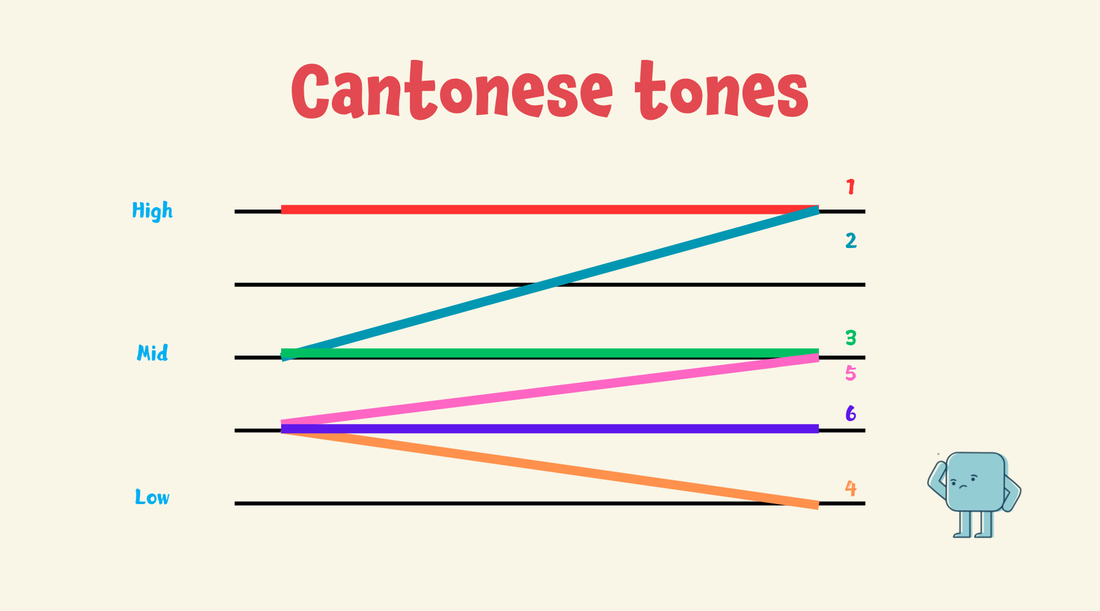
Quick Guide: What is Jyutping 粵拼?
Share
Have you ever wondered what those English letters and numbers on the Cantonese side of our cards mean? 🤔
Some of you may have guessed it—they represent Jyutping! Jyutping (粵拼) is a romanisation system specifically designed for Cantonese, developed in 1993 by the Linguistic Society of Hong Kong. It provides a standardised way to represent Cantonese pronunciation using the Latin alphabet and numbers.
Designed for consistency, Jyutping eliminates the usual English spelling confusions, so you won’t encounter puzzles like "card vs. ward," "word vs. sword," or "great vs. threat."
Remember, romanised Cantonese isn’t English! Here are the three main differences you need to know to start your Cantonese journey: unique vowel and consonant sounds, different “plosives,” and, most importantly, tones.
Vowels
aa & a
- aa: A long “aaah” sound
- a: A short “uh” sound
Example: 三 saam1 心 sam1
i
- Pronounced “ee” on its own, but with -ik sounds like “ick,” and with -ing resembles “-ing” in English.
Example: 詩 si1 識 sik1 星 sing1
e
- Pronounced like “eh.”
Example: 借 ze3
o
- Sounds like “awe,” similar to the sound in “on.”
Example: 可 ho2
u
- Pronounced “oo” on its own, with -uk it resembles “oak,” and with -ung it sounds like “ung.”
Example: 姑 gu1 谷 guk1 工 gung1
yu
- This sound doesn’t exactly exist in English. The closest approximation is “yeu”. If you speak German, than it is the sound “ü.”
Example: 書 syu1
oe & eo
- oe: Pronounced as an “e” sound with rounded lips, somewhat like “errr.”
- eo: A shorter version of “oe.”
Example: 率 seot1 削 soek3
Don’t worry if you can’t immediately tell the difference; even many native speakers struggle with these sounds.
Consonants
j
- Represents the “y” sound.
Example: 一 jat1
z & c
- z is like “z” in “zip,” and c sounds like “ch” in “chicken.”
Example: 知 zi1 詞 ci1
ng
- Unlike in English, where "ng" appears only at the end of words, in Cantonese it can also be at the start.
Example: 我 ngo5 牙 ngaa4
It may feel awkward to pronounce, but many native speakers struggle with it too, so don’t stress over perfection.
Plosives and Aspiration
b-, d-, g-
- While not exactly like English b, d, and g, these sounds are close enough for beginners.
Example: 巴 baa1 打 daa1 家 gaa1
p-, t-, k-
- Pronounced like p in “pea,” t in “tea,” and k in “key.”
Example: 趴 paa1 他 taa1 卡 kaa1
-p, -t, -k
- When appearing at the end of a word, these sounds are “unreleased.” Imagine saying them without fully pronouncing them—this can be tricky without hearing examples. It’s also why some Cantonese speakers might drop final "t" or "k" sounds in English. (I am guilty of this...)
Example: 濕 sap1 失 sat1 塞 sak1
Tones
Cantonese tones can be a bit complex. While some purists argue there are 9 or even 10 tones, Jyutping simplifies it to just 6 tones.
- High flat 2. Mid rising 3. Mid flat 4. Low falling 5. Low rising 6. Mid-low flat

Example: 夫 fu1 虎 fu2 副 fu3 扶 fu4 婦 fu5 父 fu6
And there you have it—a very quick introduction to Jyutping! With this, you should be ready to start pronouncing nearly every Cantonese word you come across. Check out our collection, and let’s begin the journey together!
